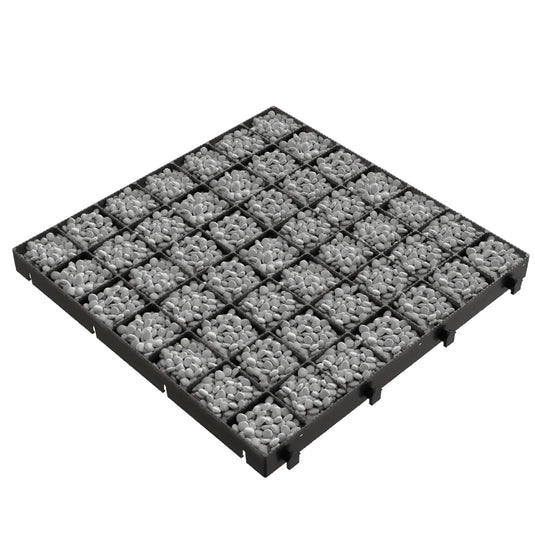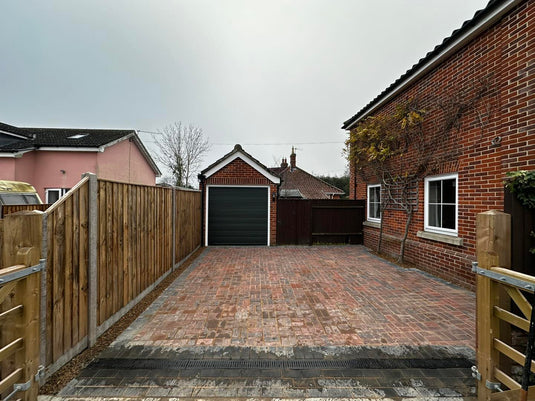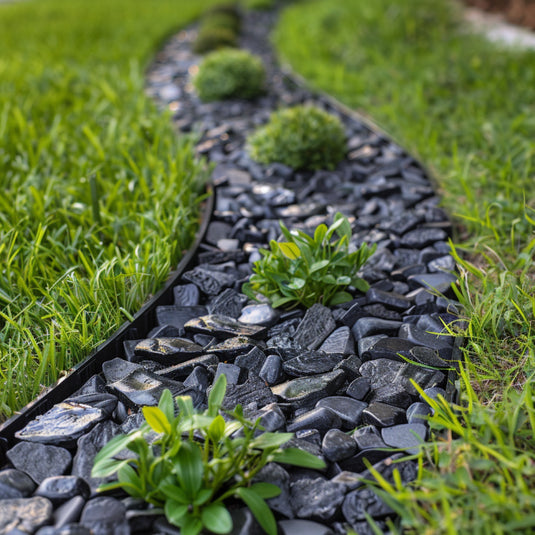Delivering a stable driveway isn’t just about looks — it’s about durability, performance, and getting the job done right. But without proper ground stabilisation, gravel driveways quickly become uneven, eroded and time-consuming to maintain.
Gravel grids for driveways provide a simple, trade-quality solution. These ground stabilisation grids keep gravel locked in place, prevent displacement, and allow natural drainage, reducing call-backs and ensuring durability for years to come.
In this guide, we’ll cover:
-
Why ground stabilisation is essential for every gravel driveway project.
-
How gravel grids improve strength, drainage, and ease of installation.
-
The key benefits for both tradesmen and their customers.
-
Simple installation steps to get the best, long-term results.
Join the IBRAN TradeHub today and get exclusive benefits, and our FREE digital toolkit when you become a member!
The Problem with Unstable Driveways
Poorly stabilised gravel driveways can become a nightmare for installers and homeowners alike. Without proper ground stabilisation, gravel shifts underfoot, creating an uneven surface that looks untidy and wears down quickly. Over time, frequent use, rain and vehicle traffic worsen the problem, leading to rutting, erosion, and drainage issues — all of which can be costly and time-consuming to put right.
Common issues with traditional gravel driveways include:
-
Loose stones and displacement: Vehicles and foot traffic push gravel out of place, creating thin patches and bare spots that require frequent refilling.
-
Erosion and poor drainage: Without a stabilisation system, rainwater washes away gravel, leading to puddles, surface runoff and deterioration.
-
Weed growth: Over time, gaps between loose stones allow weeds to grow, making upkeep harder and affecting the driveway’s long-term appearance.
-
Compaction and surface instability: Even with a well-prepared base, heavy loads compact certain areas, leading to uneven surfaces and structural weaknesses.
Many driveway projects rely on simple gravel spreading and compacting, but these methods don’t provide lasting stability. Paving or tarmac alternatives may seem like a solution, but they come with higher costs, reduced permeability and potential drainage problems.
For a low-maintenance, professional-grade driveway, ground stabilisation grids are the best solution. By reinforcing the surface, gravel grids prevent shifting, improve drainage, and create a more durable, long-lasting driveway — saving time and money on future repairs.
How Gravel Grids Solve Driveway Instability
A well-installed ground stabilisation system eliminates the biggest issues with loose gravel driveways. By reinforcing the surface, gravel grids create a stable, even foundation.
There are other benefits to using gravel grids for ground stabilisation too:
-
Eliminates gravel displacement: Grids keep gravel contained within cells, preventing it from spreading, sinking or shifting under vehicles and foot traffic.
-
Prevents erosion and drainage issues: Unlike solid surfaces, gravel grids allow water to drain through, reducing runoff and preventing pooling.
-
Improves load-bearing capacity: High-quality ground stabilisation grids distribute weight evenly, preventing ruts, dips and surface compaction.
-
Reduces maintenance: Less gravel displacement means fewer refills and lower long-term costs for property owners, improving customer satisfaction.
-
Minimises weed growth: By locking gravel in place and reducing gaps, grids help to prevent weeds from taking root, making upkeep simple.
The Sustainable Choice
Sustainability is a growing priority in construction, and ground stabilisation grids offer an environmentally friendly solution for driveway renovation projects. Allowing water to drain naturally helps reduce surface runoff and supports sustainable drainage systems (SuDS).
Our gravel grids are manufactured using 100% recycled materials, contributing to waste reduction while maintaining durability!
How to Choose the Right Ground Stabilisation Solution
With multiple options available, you need to consider several key factors to get the best results for your customers:
-
Load-bearing capacity: Different grids support different weight loads. A standard grid is good for domestic driveways, but heavier-duty grids are required for commercial parking areas or access roads used by larger vehicles.
-
Sustainability and materials: Gravel grids for driveways can be made from recycled plastics, offering a durable and eco-friendly solution. Choosing a high-quality, recycled material ensures both longevity and environmental responsibility.
-
Drainage efficiency: When paired with high-quality drainage systems, water will drain naturally, preventing pooling and surface runoff into other areas. This is particularly important in areas with heavy rainfall or clay-heavy soil.
-
Grid cell size and gravel compatibility: The cell size of the grid affects gravel retention. Smaller cells provide better containment, reducing movement, while larger cells may be more economical for bigger projects.
-
Installation: Some grids feature interlocking designs for easier installation, while others require securing with anchors. Choosing a system that balances stability and ease of installation can save valuable time on-site.
Choose IBRAN for trade-quality gravel grids that ensure fewer long-term maintenance issues, a more professional finish, and a reduced risk of gravel displacement. Investing in the right stabilisation grid means better results for both yourself and your customers.
How to Install a Ground Stabilisation Grid
A correctly installed ground stabilisation grid ensures a long-lasting, professional-grade driveway. Whether for domestic driveways or commercial spaces, following these steps will prevent gravel displacement, improve drainage, and reduce future maintenance.
Prepare the Ground
You need to make sure you have a solid foundation for a durable and stable driveway. Follow these steps to make sure the ground is prepared properly:
-
Clear the area: Remove all debris, weeds, and loose gravel to create a clean working surface.
-
Excavate to the correct depth: Dig to a minimum depth of 210mm, making sure there’s enough space for the sub-base, sand, grids and stone overfill. The exact depth depends on soil conditions and expected load, so we’ve created a sub base calculator to help you determine this.
-
Install the sub-base: A 150mm compacted layer of MOT Type 1, 2 or 3 aggregate will form the best foundation for your driveway. This material provides excellent load-bearing capacity and prevents sinking. Spread the aggregate evenly, and lightly moisten it to help with compaction.
-
Compact the sub-base: Use a whacker plate or compactor to compress the aggregate, making sure you’re left with a firm, level surface. If using a deeper sub-base, compact it in separate 50mm layers rather than all at once.
-
Apply a sand blinding layer: Before installing the gravel grids, add a 10mm layer of sharp sand over the compacted sub-base. This creates a smooth, even surface and helps stop the sub base from moving into the greed layer. Lastly, to minimise weed growth, install a weed suppressant membrane over the sand.
For an in-depth breakdown of each step, read our detailed guide on how to lay gravel grids.
Lay a Permeable Membrane
A geotextile membrane prevents weed growth while allowing water to drain freely.
-
Cut the membrane to fit the area.
-
Overlap the edges slightly to prevent gaps where weeds could grow.
Using a non-permeable sheet is not recommended, as it can cause water pooling and drainage issues.
Position the Gravel Grids
Now, place the ground stabilisation grid:
-
Start at one edge and work across the area.
-
Interlock the grids securely, if applicable, to create a seamless surface.
-
Ensure each panel is tightly aligned to prevent movement.
For sloped surfaces, ground pegs may be required to anchor the edges and prevent shifting.
Fill with Gravel
The final step is adding the gravel:
-
Use angular gravel (10–20mm) for better interlocking and stability.
-
Spread evenly, ensuring each cell is fully filled.
-
Lightly compact the surface to create a firm, stable finish.
Complete Final Checks
Walk or drive over the surface to ensure the gravel is evenly distributed and the grids are securely in place. Over time, natural settling may occur, so an occasional top-up of gravel may be needed.
Ready to get started? The IBRAN Gravel Grids provide strong load-bearing capacity, easy installation, and excellent drainage performance.
Common Questions About Driveway Stabilisation Techniques
Tradesmen and property owners often have questions about gravel grids for driveways, covering everything from installation to long-term performance. Here are answers to the most common questions that you might have,
Do gravel grids really make a difference?
Yes. Ground stabilisation grids prevent gravel shifting, rutting and uneven surfaces, making driveways easier to maintain while improving drainage. Without a grid, gravel moves underfoot and under vehicles, leading to frequent refilling and maintenance.
Can gravel grids handle heavy vehicles?
It depends on the grid’s load capacity. High-quality grids are designed to support cars, vans, and even heavier commercial vehicles without sinking or warping.
Do gravel grids improve drainage?
Yes. Unlike solid surfaces like tarmac or concrete, a permeable ground stabilisation grid allows water to drain naturally into the ground, reducing surface runoff and preventing puddles or flooding.
Are gravel grids difficult to install?
Not at all. Once the ground is prepared and level, the grids simply interlock and are filled with gravel. A standard domestic driveway can usually be installed in a day with basic tools.
What’s the best gravel size to use with a stabilisation grid?
Angular gravel between 10-20mm is ideal. Smaller stones may compact too much and block drainage, while larger stones won’t sit securely within the grid cells.
Will weeds still grow through a gravel grid?
A properly installed geotextile membrane underneath the grid prevents weeds from taking root, significantly reducing maintenance.
Are gravel grids an eco-friendly option?
Yes, especially when made from 100% recycled materials. They also support Sustainable Drainage Systems (SuDS), helping to manage rainwater naturally rather than overloading drainage networks.
The Smarter Choice for Driveway Stability
A well-constructed gravel driveway needs to look professional and maintain its condition in the long term. Without proper ground stabilisation, gravel shifts, erosion occurs, and drainage suffers, leading to costly repairs and ongoing maintenance. A gravel grid solution ensures a stable, even surface that withstands daily use, reduces upkeep, and enhances drainage, preventing flooding and runoff issues.
That’s where IBRAN Gravel Parking Grids come in. Engineered for strength and durability, they provide a professional-grade solution that’s easy to install and built to last. Plus, they’re made from 100% recycled materials — giving you an eco-friendly way to enhance your projects.
Join the IBRAN TradeHub today for instant access to our FREE digital toolkit, designed to help you work smarter and deliver the best results.






